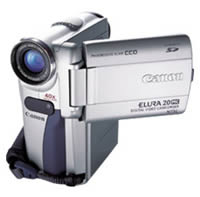Canon Elura 10 Digital Camcorder
Canon Updated: 2007-08-02Compact and versatile, the Elura 10 offers a unique blend of features to produce both high-quality video and stills - from one camera. These camcorders are designed for those who want point-and-shoot simplicity without limiting their ability to take command and stretch their creative wings when they want to.
The Elura 10 offers the superior quality of digital video, the ability to take digital still pictures, several shooting options, digital effects, and quick and easy connection to your computer.
To enhance your shooting experience with the Elura 10, Canon offers a wide selection of optional accessories. Regardless of your shooting style, Canon has the right accessory to create professional results every time.
Features
- Digital Video Format and IEEE 1394
- Progressive Scan CCD
- RGB Primary Color Filter
- Image Stabilizer
- Precision Canon Optical Zoom Lens
- Shooting Modes
- Color Viewfinder and 2.5" LCD Screen
- Programmed Auto Exposure
- Manual Controls
- Digital Effects, Faders and Special Effects
- PCM Digital Stereo Sound
- IEEE 1394 Input and Output Terminal
- Video and Audio Inputs and Outputs
- Additional Features
Digital Video Format and IEEE 1394
The Canon Elura 10 is a digital video camcorder, using the standard MiniDV cassette; it produces the highest quality video possible from non-broadcast equipment. The MiniDV format standard delivers more than 500 lines of horizontal resolution. This is about a 25% improvement in picture quality over the best analog formats. On top of that, because it records both video and audio as digital data, this information can be transferred - without any loss of picture or audio quality -- to computer for editing, then transferred back to DV tape, without a reduction in either picture or audio quality. All of this is through the use of the IEEE 1394 protocol commonly known as FireWire®.
DV Format Technology and Advantages
The DV format is based on a robust videotape formulation, a sophisticated and computer-based data capture system, the ability to allow the high speed transfer of data from camcorder to tape, and a standard data structuring system. The MiniDV format makes professional quality video affordable.
Better picture quality than analog, sharper images and better color reproduction: that's what digital video is all about! Digital recordings are almost immune to signal problems, and deliver the highest quality picture and audio. This is a major advantage over analog. Digital is the language of computers, which easily store and transfer data without distortion. It is exactly the same with digital video. Digital copies of digital videos are indistinguishable from the original, which makes editing and image manipulation so much easier and with higher quality than that delivered by analog video technology.
The tape formulation is designed to last longer and even withstand repeated use without failure, which virtually eliminates dropouts while delivering higher output and less noise.
Digital video has approximately twice the horizontal resolution of a standard VHS videocassette recorder. The resolution of a DV standard image is about 25% better than that from an S-VHS or Hi8 camcorder or deck. While resolution is dependent on a product's components and circuitry, standard VHS and 8mm video are capable of delivering about 250 lines of horizontal resolution with S-VHS and Hi8 at about 400-420 lines. The DV format is capable of delivering more than 500 lines of horizontal resolution, with actual performance depending on the individual camcorder model. Another way to look at it is that an NTSC digital video signal contains three times the data of its analog counterpart; a PAL digital video signal contains six times the data of its analog counterpart.
Color resolution (or rendition) can be a problem for analog video, producing color blur and color noise. Digital video does not have this problem, delivering a far more lifelike video image on the screen. What you will see is much sharper subject edges and clearer color reproduction.
The MiniDV standard ensures that audio quality matches that of an audio CD or digital audio tape (DAT). The audio portion of the digital video signal is recorded digitally. The digital video standard includes Pulse Code Modulation (PCM) audio recording, delivering more than the normal, natural range of sound audible to humans without both distortion and noise.
All digital video equipment also have the analog video outputs (either S-video and/or composite video) found on current analog equipment so you can play a digital video on a regular TV, or transfer a digital video onto an analog VCR. If you record using a digital video camcorder, you can then copy the video onto VHS or Super-VHS tapes, 8mm or Hi8 tapes, or any of the broadcast formats such as 3/4-inch or Betacam if they have the appropriate input connectors.
Elura 10 and Elura 20MC Instruction Manual
Power Adapter CA-400
Battery packs BP-406, BP-412 & BP-422
Power Adapter CH-910 Instruction Manual
Power Adapter CB-400
Fulter Sets FS-27U
Video Light VL-10Li
Zoom Remote Controller ZR-1000
Related Manuals
Canon Optura Xi Digital Camcorder
Canon Optura 300 Digital Camcorder
Canon Elura Digital Camcorder
Canon Elura 2MC Digital Camcorder
Canon Elura 40MC Digital Camcorder
Canon Optura 200MC Digital Camcorder
Canon ES75 Analog 8mm Camcorder
Canon Optura 100MC Digital Camcorder
Canon Optura 20 Digital Camcorder
Canon ES8400V Analog 8mm Camcorder
Canon Optura 50 Digital Camcorder
Canon Ultura Digital Camcorder
